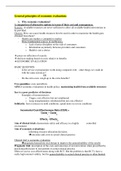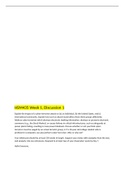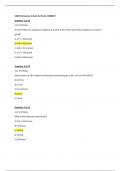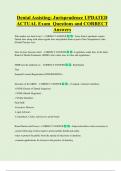General principles of economic evaluations
1. Why economic evaluations?
A comparison of alternative options in terms of their cost and consequences.
Scarcity: Available resources are never sufficient to allow all available health interventions to
be provided.
Choices: How can scarce health resources best be used in order to maximise the health gain
obtained from them?
- Health care market ≠ competitive market
- Three fundamental sources of inefficiency
o Lack of price discipline on the side of consumers
o Information asymmetry between providers and consumers
o Health is not a choice
→ prices no reflection of scarcity
→ decision making based on costs relative to benefits
→ ECONOMIC EVALUATION
BASIC QUESTION:
- Is the service or programme worth doing compared with other things we could do
with the same resources?
OR
- Do the extra costs weigh up to the extra benefits?
Two quantities: costs and effects.
AIM of economic evaluations in health policy: maximizing health from available resources
Icer is a poor predictor of decisions
- Examples of inconsistencies
o Viagra: cost-effective but not reimbursed
o Lung transplantation: reimbursed but not cost-effective
Solidarity: Save resources in mild conditions; spend more on severe conditions
Incremental Cost-Effectiveness Ratio (ICER) =
Costs – Costs
I C
/
Effects - Effects
I C
Aim of clinical trials: demonstrate safety and efficacy in a highly controlled
environment
Aim of economic evaluations:
informing resource allocation decisions
➔outcomes and costs in actual clinical practice
Clinical trial vs economic evaluation
➔pragmatic/naturalistic trial design to improve the generalisability of the results
Pragmatic trial: description of the costs and outcomes of an intervention when prescribed by
practicing physicians to real patients in actual clinical practice.
Often we access cost-effectiveness along with RCT. But the problem is that RCT’s have a
really high internal validity, but the generalizability to actual clinical practice is often limited.
,This means that we want to have a pragmatic or naturalistic RCT, which have serious
consequences for the design of the trial:
1. First one is the choice of comparator (control). By a RCT the comparator is often
placebo, but this is not valid for economic evaluation where we also want the
estimate the cost-effectiveness. Because placebo is not a (valid) intervention that
health care providers will implement in actual clinical practice. So you want to select a
comparator that resembles actual clinical practice, so that may be the most often used
intervention, or an intervention that is used in current guidelines. And sometimes it
will be no intervention available for specific health condition.
2. The second issue is protocol-driven care.
a. Protocol-driven care: resources consumed for trial purposes that would not
typically be consumed in standard clinical practice
b. Often in RCT’s to monitor patients additional blood test are done, or medical
imaging to evaluate whether there are protentional side effects or so. But in
economic evaluations in RCT designed to also estimate cost effectiveness you
don’t want these types of protocol driven care or additional care. You don’t
want to take these into account, because this will lead to an overestimation of
the costs of the interventions.
• Case-finding: discovery of a previously undetected condition during a protocol-
mandated visit or diagnostic test
• Frequent monitoring
• Use of gold standard measurement of outcomes
Golden standard measurement:
- Trial comparing alternative acid suppressant drugs to prevent recurrent duodenal
ulcers
- Clinical trials: endoscopy at fixed follow-up times
- Routine practice: management based on clinical symptoms
3. Blinding: In a high quality RCT preferably physicians and patients are blinded to the
intervention that is been given to a patient. However in actual clinical practice, which
treatment someone gets will effect which type of monitoring you’ll apply:
a. like if you know a specific intervention has the risk of high blood pressure,
then you’ll measure the blood pressure more regularly. If you don’t know
which intervention your patient receives, you’ll do that to all patient, whereas
it’s only needed for just some of them. This will results in an increase in costs.
4. One of the most important aspects is that the study population and study sites that
you include in your RCT would be representative of the total population.
a. Clinical trials: patients carefully selected to minimize biological variation and
highlight the treatment effect
b. Economic evaluations: patients representative of the target population
including those with severe symptoms, comorbidity or risk factors effect
5. The time horizon should be long to capture the full consequences/all potential health
effects and cost of the intervention.
a. often lifetime
b. intermediate versus final outcomes, e.g. blood pressure versus heart attack
, c. Follow-up often terminated when the participant reaches a predetermined
endpoint. However, there may be important costs associated with reaching
such an endpoint! → Follow-up until the end of the follow-up period
Summary
- Resources available for health care are scarce
- Prices do not reflect scarcity on a health care market
- Economic evaluations can inform resource allocation decisions
- But this has important consequences for the design of these studies
2. Cost-effectiveness in medicine is not a dirty word
We can use the utility value to calculate the qaly.
QALY= quality adjusted life years. This takes into account both how long you going to life as
well as the quality of life you have while alive.
Utility value x # years = QALY
If an intervention costs 100000dollars / by 4 Qalys= it’s 25000 per QALY, which is cost-
effective.
3. Design principles of economic evaluations
Healthcare are the highest cost in the Netherlands and there are two reasons for this increase:
- Degraying (aging?) of the population, we become older and there are relatively more
older people in the population than younger people.
- Developing of new technologies, preventive/diagnostic technologies, the feature that
they have in common is that they are generally much more expensive than the care we
are providing.
The budget that we have available is not sufficient to fulfil this complete demand of
healthcare. There economic evaluation is becoming more popular, we want to form decisions
on how to spend the healthcare budget in such a way that it maximizes the health benefits.
The first type (cost minimization) is actually not a type of evaluation because we assume that
the health effects of both interventions are equal, so no differences. In that case we are only
interested in the lowest costs. However, generally this is not the case. There are three types of
economic evaluation in which we make a comparison of health effects and costs.
1. Cost-effectiveness: most used. In this we express the health effects of the intervention
and disease specific units.
a. Single major outcome common to alternatives being compared.
b. No valuation of outcomes, natural units. For instance blood pressure or
severity of depression symptoms.
2. Cost-utility (also one of most used): In this type we express health effects in QALY.
QALY has the advantage that you can calculate it for any disease, any intervention
and that they mean the same.
3. Cost-benefit: in this type health effects are expressed as monetary units. You can
easily compare them. It’s very difficult to convert health effects to monetary units.
People find it hard/unethical to do that.
1. Why economic evaluations?
A comparison of alternative options in terms of their cost and consequences.
Scarcity: Available resources are never sufficient to allow all available health interventions to
be provided.
Choices: How can scarce health resources best be used in order to maximise the health gain
obtained from them?
- Health care market ≠ competitive market
- Three fundamental sources of inefficiency
o Lack of price discipline on the side of consumers
o Information asymmetry between providers and consumers
o Health is not a choice
→ prices no reflection of scarcity
→ decision making based on costs relative to benefits
→ ECONOMIC EVALUATION
BASIC QUESTION:
- Is the service or programme worth doing compared with other things we could do
with the same resources?
OR
- Do the extra costs weigh up to the extra benefits?
Two quantities: costs and effects.
AIM of economic evaluations in health policy: maximizing health from available resources
Icer is a poor predictor of decisions
- Examples of inconsistencies
o Viagra: cost-effective but not reimbursed
o Lung transplantation: reimbursed but not cost-effective
Solidarity: Save resources in mild conditions; spend more on severe conditions
Incremental Cost-Effectiveness Ratio (ICER) =
Costs – Costs
I C
/
Effects - Effects
I C
Aim of clinical trials: demonstrate safety and efficacy in a highly controlled
environment
Aim of economic evaluations:
informing resource allocation decisions
➔outcomes and costs in actual clinical practice
Clinical trial vs economic evaluation
➔pragmatic/naturalistic trial design to improve the generalisability of the results
Pragmatic trial: description of the costs and outcomes of an intervention when prescribed by
practicing physicians to real patients in actual clinical practice.
Often we access cost-effectiveness along with RCT. But the problem is that RCT’s have a
really high internal validity, but the generalizability to actual clinical practice is often limited.
,This means that we want to have a pragmatic or naturalistic RCT, which have serious
consequences for the design of the trial:
1. First one is the choice of comparator (control). By a RCT the comparator is often
placebo, but this is not valid for economic evaluation where we also want the
estimate the cost-effectiveness. Because placebo is not a (valid) intervention that
health care providers will implement in actual clinical practice. So you want to select a
comparator that resembles actual clinical practice, so that may be the most often used
intervention, or an intervention that is used in current guidelines. And sometimes it
will be no intervention available for specific health condition.
2. The second issue is protocol-driven care.
a. Protocol-driven care: resources consumed for trial purposes that would not
typically be consumed in standard clinical practice
b. Often in RCT’s to monitor patients additional blood test are done, or medical
imaging to evaluate whether there are protentional side effects or so. But in
economic evaluations in RCT designed to also estimate cost effectiveness you
don’t want these types of protocol driven care or additional care. You don’t
want to take these into account, because this will lead to an overestimation of
the costs of the interventions.
• Case-finding: discovery of a previously undetected condition during a protocol-
mandated visit or diagnostic test
• Frequent monitoring
• Use of gold standard measurement of outcomes
Golden standard measurement:
- Trial comparing alternative acid suppressant drugs to prevent recurrent duodenal
ulcers
- Clinical trials: endoscopy at fixed follow-up times
- Routine practice: management based on clinical symptoms
3. Blinding: In a high quality RCT preferably physicians and patients are blinded to the
intervention that is been given to a patient. However in actual clinical practice, which
treatment someone gets will effect which type of monitoring you’ll apply:
a. like if you know a specific intervention has the risk of high blood pressure,
then you’ll measure the blood pressure more regularly. If you don’t know
which intervention your patient receives, you’ll do that to all patient, whereas
it’s only needed for just some of them. This will results in an increase in costs.
4. One of the most important aspects is that the study population and study sites that
you include in your RCT would be representative of the total population.
a. Clinical trials: patients carefully selected to minimize biological variation and
highlight the treatment effect
b. Economic evaluations: patients representative of the target population
including those with severe symptoms, comorbidity or risk factors effect
5. The time horizon should be long to capture the full consequences/all potential health
effects and cost of the intervention.
a. often lifetime
b. intermediate versus final outcomes, e.g. blood pressure versus heart attack
, c. Follow-up often terminated when the participant reaches a predetermined
endpoint. However, there may be important costs associated with reaching
such an endpoint! → Follow-up until the end of the follow-up period
Summary
- Resources available for health care are scarce
- Prices do not reflect scarcity on a health care market
- Economic evaluations can inform resource allocation decisions
- But this has important consequences for the design of these studies
2. Cost-effectiveness in medicine is not a dirty word
We can use the utility value to calculate the qaly.
QALY= quality adjusted life years. This takes into account both how long you going to life as
well as the quality of life you have while alive.
Utility value x # years = QALY
If an intervention costs 100000dollars / by 4 Qalys= it’s 25000 per QALY, which is cost-
effective.
3. Design principles of economic evaluations
Healthcare are the highest cost in the Netherlands and there are two reasons for this increase:
- Degraying (aging?) of the population, we become older and there are relatively more
older people in the population than younger people.
- Developing of new technologies, preventive/diagnostic technologies, the feature that
they have in common is that they are generally much more expensive than the care we
are providing.
The budget that we have available is not sufficient to fulfil this complete demand of
healthcare. There economic evaluation is becoming more popular, we want to form decisions
on how to spend the healthcare budget in such a way that it maximizes the health benefits.
The first type (cost minimization) is actually not a type of evaluation because we assume that
the health effects of both interventions are equal, so no differences. In that case we are only
interested in the lowest costs. However, generally this is not the case. There are three types of
economic evaluation in which we make a comparison of health effects and costs.
1. Cost-effectiveness: most used. In this we express the health effects of the intervention
and disease specific units.
a. Single major outcome common to alternatives being compared.
b. No valuation of outcomes, natural units. For instance blood pressure or
severity of depression symptoms.
2. Cost-utility (also one of most used): In this type we express health effects in QALY.
QALY has the advantage that you can calculate it for any disease, any intervention
and that they mean the same.
3. Cost-benefit: in this type health effects are expressed as monetary units. You can
easily compare them. It’s very difficult to convert health effects to monetary units.
People find it hard/unethical to do that.





